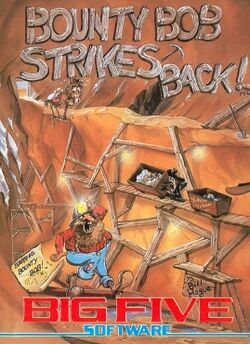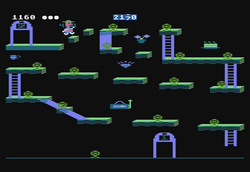Software:Bounty Bob Strikes Back!
| Bounty Bob Strikes Back! | |
|---|---|
 | |
| Developer(s) | Big Five Software |
| Publisher(s) | |
| Programmer(s) | Bill Hogue |
| Artist(s) | Curtis Mikolyski Bill Hogue |
| Platform(s) | Atari 8-bit, Atari 5200, Commodore 64, Amstrad CPC, ZX Spectrum, BBC Micro |
| Release | 1985: Atari 8-bit,[1] 5200, C64, CPC, Spectrum |
| Genre(s) | Platform |
| Mode(s) | Single-player |
Bounty Bob Strikes Back! is the sequel to Miner 2049er published in 1985[1] for the Atari 8-bit family. The game adds a pseudo-3D look to the platforms and increases the level count from 10 to 25. As with the original, the Atari 8-bit version was released on ROM cartridge.[2] A port for the Atari 5200 was released the same year, followed by versions for the Commodore 64, Amstrad CPC, and ZX Spectrum also in 1985.
In 2001,[lower-alpha 1] Bill Hogue, the game's developer, released the game and its prequel, Miner 2049er, for free online with an embedded Atari 8-bit computer emulator.[4]
Gameplay
Gameplay is similar to Miner 2049er in that the player must inspect every section of 25 mines while avoiding mutants within a set time. One difference from the original game is that after losing a life, sections on platforms remain covered and destroyed enemies do not reappear, thus making it easier to complete a level.
Development
Following the critical and financial success of his game Miner 2049er, programmer Bill Hogue began work on a game titled Scraper Caper which would have Bounty Bob become a fire fighter. Following a lot of advertising, the game was never released. Hogue would work on his next game Bounty Bob Strikes Back.[5]
The game featured enhancements from the first game, such as a slight 3D effect on the platforms to add dpeth and that when the player loses a life, they did not lose all the progress in their gameplay.[5] The game also expanded on the amount of levels, having 25 over the originals 10.[6]
On Atari systems, it is a bank-switched cartridge of 40KB total program and data mapped onto 16KB of address space.[7][1]
Reception
The game reached number nine on Billboard's list of top-selling entertainment computer software in June 1985,[8] despite clocking in at a hefty equivalent to $119 in 2019.[1]
In Steve Panak's column for ANALOG Computing, he found the large number of screens and the different elements in them to be a strong point: "It is this variety which saves Bob from mediocrity."[9] He didn't like the unskippable animations when a new entry is added to the high score table, especially as the scores only persist until the computer is turned off.
In the final issue of Your Sinclair, the ZX Spectrum version was ranked number 56 on "The Your Sinclair Official Top 100 Games of All Time."[10] In 2004, the ZX Spectrum version was voted the 19th best game of all time by Retro Gamer readers in an article originally intended for a special issue of Your Sinclair bundled with Retro Gamer.[11]
Legacy
On reflecting on the sequel, Hogue said thought it was a great follow-up to the original game, but "perhaps not the groundbreaking game we wanted it to be and I guess that still disappoints me."[5]
Notes
References
- ↑ 1.0 1.1 1.2 1.3 Leyenberger, Arthur (1985-04-01). "Winter CES: Part 2". ANALOG Computing. https://archive.org/details/analog-computing-magazine-29/page/n86/mode/1up. Retrieved 2023-06-11.
- ↑ Friedland, Nat, ed (May 1985). "New Products". Antic (San Francisco, CA: Antic Publishing) 4 (1): 90. ISSN 0745-2527. https://archive.org/details/1985-05-anticmagazine/page/n89.
- ↑ Hogue, Bill. "Big Five Software - Emulator". http://www.bigfivesoftware.com/Emulator/emulator.htm.
- ↑ Hogue, Bill (18 January 2007). "Big Five Software - Emulator". http://www.bigfivesoftware.com/Emulator/emulator.htm.
- ↑ 5.0 5.1 5.2 Hawken & Jones, p. 37.
- ↑ Hawken & Jones, p. 38.
- ↑ Stehlik, Petr (2023-04-29). "Atari800 emulator supported cartridge images". https://github.com/atari800/atari800/blob/dc68c7ff6d6d9c7fa6a9574766cc83ad626c553b/DOC/cart.txt#L366.
- ↑ Billboard Publications (2 June 1985). "Software best sellers". The Record (Hackensack, NJ: John Borg) 90 (305): p. O-11. https://www.newspapers.com/clip/28341077/software_best_sellers_by_billboard/.
- ↑ Panak, Steve (June 1985). "Panak Strikes". ANALOG Computing (31): 68. https://archive.org/details/analog-computing-magazine-31/page/n69/mode/2up.
- ↑ Nash, Dennis, ed (September 1993). "Let the People Decide! The Results". Your Sinclair (Future Publishing) 1 (93): 11–12. https://archive.org/details/your-sinclair-93/page/n57.
- ↑ Whitehead, Dan (25 June 2009). "The 50 Best Speccy Games Ever!". Nick Humphries. http://www.ysrnry.co.uk/articles/50bestspeccygames94.htm.
Sources
- Hawken, Kieren; Jones, Darran. "Ultimate Guide: Bounty Bob Strikes Back!". Retro Gamer (191). https://archive.org/details/retro-gamer-raspberry-pi-buenos-aires/Retro%20Gamer%20191/page/36/mode/1up.
External links
- Bounty Bob Strikes Back! at Atari Mania
 |


